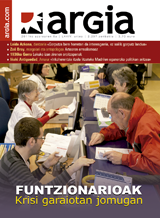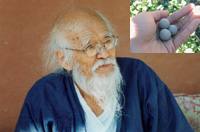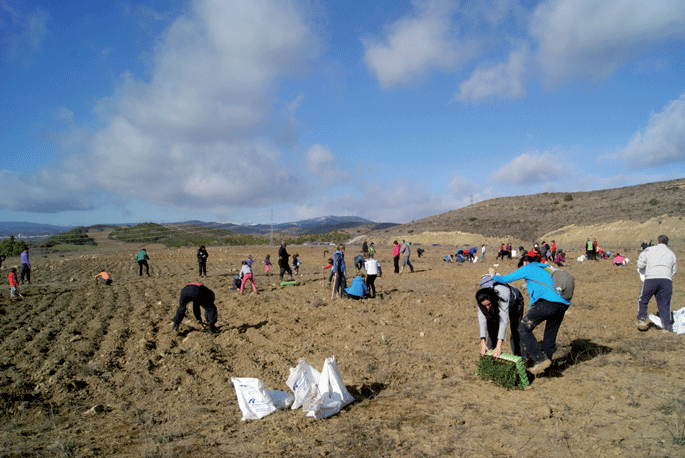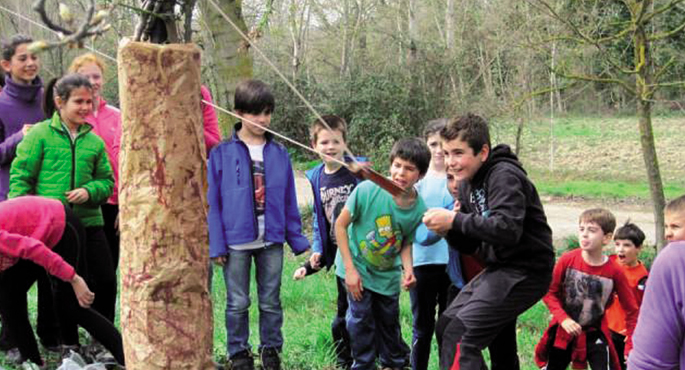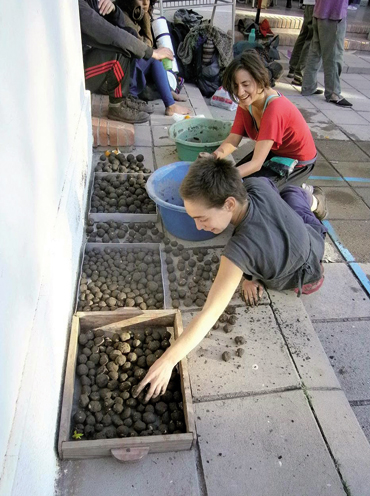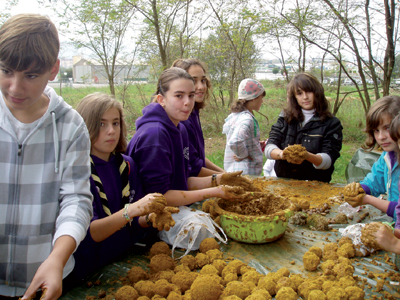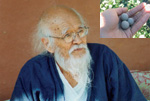From the seed to scream the world
- The forest, which was once populated with forests, has to be domesticated again, as everyone knows. In addition to the sea, biodiversity is based on sotans, climate regulation and the soil itself necessary for food production. The “Nendo Dango” technique, designed by Masanobu Fukuoka, is increasingly used to repopulate arized areas.
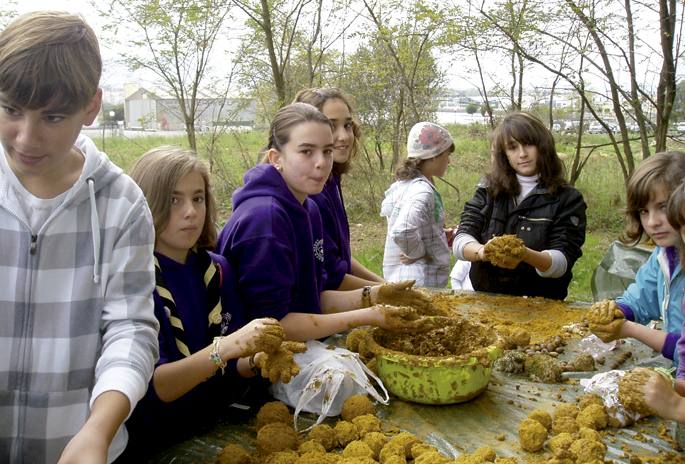
The children of the Sodupe de Güeñes (Bizkaia) and Joseba García Lizarralde, responsible for the forests of that municipality, revolutionized the Basque Country in February 2010. The journalist Julen Nafarrate told in Berria: “Doing nothing, planting. In Güeñes, an extraordinary path towards reafforestation has been followed. On the occasion of Tree Day they have planted acebos following the Japanese technique of Nendo Dango”. Sowing has served to deal with two crises.
In the chronicle García Lizarralde suggested to the journalist that two years ago the City Hall had to cut back on the mountain’s repopulation budget with children and gave venes.Con the fall of the economy, the Spanish economy has already recovered and will not be enriched in 2011. It comes out cheaper than buying plants to take children to the mountain, collect seeds from trees or leaves and sow them in clay pellets.
Another crisis that Nendo Dango wants to revolutionize is the deterioration of the environment. The world has a shortage of trees. And once the new forests begin to populate, we humans resort to inefficient systems: in the drilling of the introduction of plants that will hardly grow, the soils that have already lost strength deteriorate further with these tasks. Nendo Dan's technique was invented by the Japanese Masanobu Fukuoka (1913-2008). Fukuoka tried to combine trees and plants that produce other crops in the fields and cultivate them as naturally as possible, and it is one of the four or five main references of organic farming. The permaculturers recognize him superiority, as do most unharmed peasants.
Nendo Dango invented Nendo Dango when the world collapses, which in the end is to obtain in the simplest and most economical way possible that germinates and grows the most trees, forming new and durable forests, tree sown, scrub and herbaceous in pellets.
The technique is simple. Make balls or clay marbles or small bowling or disco with the seeds you want to sow. So each ball or bun will bring in three kinds of seeds. On the one hand, herbs and legumes that will germinate with the first rains. Next to them, the shrub and scrub seeds. And finally, those of trees and trees that will most easily germinate and take root in the ecosystem organized by the previous ones.
These balls, which have been left to dry for some time, will then be taken to the place where you want to see the formation of a new forest, throwing them on the flank, and tell them, Pelayo. Nature will do its job. With the rain, the seeds start to germinate one after the other by the clay that has protected them.
Fukuoka wanted to hit two birds with the bugs. On the one hand, tear up the land as little as possible, following the Taoist Wu-Wei (Do not do), who was also engaged in agriculture. On the other hand, sow as many trees as possible. The drying of the world concerned him. In one of the last interviews, he finally told a journalist: “I tell him that to throw the books, you don’t have to think so much. Put whatever you want in the article, but put it in the last lines: ‘This dialogue is useless.’ We have to sow the clay pellets soon, because we don’t have time.”
Alternative: pruning of scrubs
Dango Nendo is a place of easy and extensive use in areas that are becoming deserts in the world. The dream of Fukuoka itself was precisely to massively sow the seed pellets, even with planes and helicopters, producing clay balls in an almost industrial way.
Cultivation techniques that integrate trees and crops are becoming increasingly widespread throughout the world. In forests grow plants that guarantee human food in a land that has been bred for thousands of years. After long centuries of neglected exploitation, the fields call for the help of forests in all of them.
The broken tree branch (BRF Bois Raméal Fragmenté, in French) can have a lot in the process of restoring or recovering land. This explains, in addition to the need for wood and wood for fire, the interest that has aroused the planting or planting of trees among many farmers around the world. BRF does not require large trees, branches less than 7 centimeters in diameter are crushed.
In the race against the clock that the desert has forced the human being, many are striving in the world. The Kenyan Nobel laureate Wangari Maathai, founder of the Green Belt Mouvement, has just died and managed to plant millions of new trees in Kenya and other African countries, with a job that the women of the villages have fundamentally assumed. Most of them plant small trees in nurseries. But how do we get forests to grow more?
The 10th International Permaculture Congress was held in Jordan in September. Permaculture is a broad and varied movement around the world (founded in Australia by Bill Morrison) that, in two words, works on ways to sustainably meet all your needs. In Jordan, water was his main source of pain, but among the speakers Tony Rinaudo presented this interesting lesson: Overcoming desertification in arid areas.
Rinaudo, a member of Australia’s NGO World Vision, showed the fruits of the FMNR Farmer Managed Natural Regeneration system. Also in almost completely dried areas there are shrubs, small trees or buds that in some way inhabit the tops of cut trees. These fragile slugs produce new forests with the FMNR technique from their care, sprouting and multiplication.
In each village the baserritarras define the area that they want to repopulate, choose which branches to leave to go forward and which to prune, taking measures to protect the young plants from livestock, fighting fires, etc.
Rinaudo showed in the slides the fruits of the auzolan in a few years, uncovering its advantages: bringing wood to the villages for the benefit of the children and women who have to go to pick it up, wood for buildings and appliances, increasing feeding, improving the quality of the soil, decreasing erosion and enrichment of groundwater and sources, returning birds and woodlands, etc.
Sowing seed and pruning a firm head, one does not remove the other. Fukuoka would be at ease in both of these things, helping nature with minimal human strength. Wu-Wei, I mean.
Nafarroako Ikastolen Elkarteak eta bertako ikastolak antolaturik, Zangozako zabortegi zaharreko lurra berreskuratuko du basoak, “La Celada” deituriko parajean. Bertan jaurtiko ditugu Argia Egunean haziz eta buztinez eginiko nendo-dango bolaxkak ere.
Jasangarritasuna, parekidetasuna, lurraldetasuna, euskaltzaletasuna eta parte-hartzea. Bost balio horiek hartu ditugu kontuan egitaraua adosterakoan, oholtzaratuko diren izenak bilatzerakoan, zerbitzatuko ditugun elikagaiak hautatzerakoan...Hona irailaren 27an Usurbilen... [+]
Zuhaitz, sastraka eta beste landareen haziak nahastu buztin eta konpostetan, bola txikitan bildu eta erein. Beste edozein jolas bezain atsegina da Argia Egunean praktikatuko dugun Nendo Dangoa eta, gainera, gizakiok antzutu ditugun lur eremuei arnas berria itsatsiko diegu.
Nendo Dango tailerra dago antolatuta, beste hainbat ekitaldiren artean, irailaren 27ko ARGIA Egunerako Usurbilen. Teknikaren zehaztapenak “Hazitik hasita mundua oihantzeko” kronikan azalduta daudenez, hona laburpena.
Euskaltzaleak, ARGIAko irakurleak, langileak, kolaboratzaileak, harpidedunak, blogariak, sare sozialetako jarraitzaileak... azken finean, ARGIAren inguruan batzen garen komunitatea elkar ezagutu eta egun eder bat pasatzeko aukera emango digu aurten berreskuratuko dugun ARGIA... [+]
Noizbait basoz beteta egon zen ludia berriro oihanez beztitu beharra dago, edonork dakienez. Itsasoaz gain, zuhaizpeetan datza bioaniztasuna, klimaren erregulazioa eta elikadurak ekoizteko beharrezkoa den lurzorua bera. Masanobu Fukuokak asmatutako “Nendo Dango”... [+]
Ez bakarrik pozoirik eta ongarri sintetikorik gabe, soro-baratzeak goldatu eta jorratu gabe lantzea aldarrikatu zuen Masanobu Fukuokak, nekazaritza naturalaren aitzindariak. Laborantzak naturarekiko errespetuan eta gizakiaren garatze espirituzkoan oinarritu behar duela zioen.









